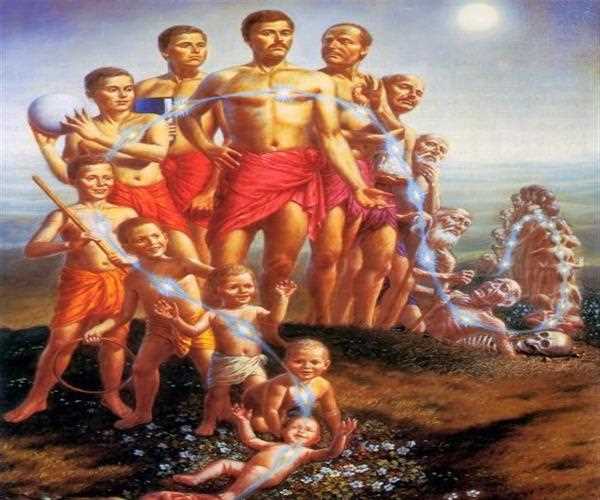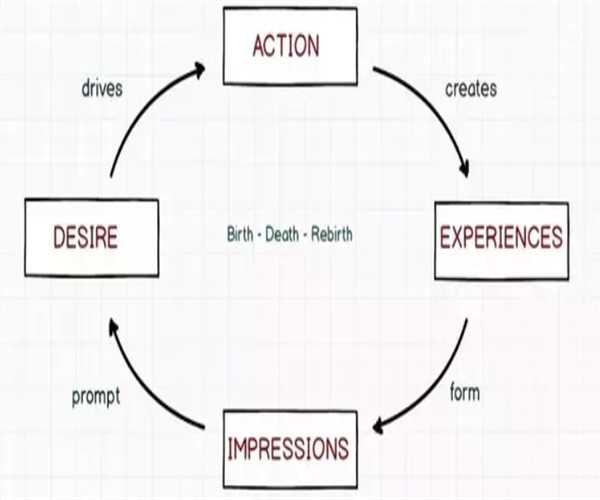
06-Nov-2023 , Updated on 11/6/2023 9:16:00 PM
Raw Truth of the cycle of birth, death and rebirth in Hinduism
In our Hinduism, there are 84 lakh yonis and we all have to wander ourselves one day in the cycle until and unless we get salvation or moksha.
It totally depends upon the karma and your standards of living into your life.
The idea of rebirth is a crucial confidence in Hinduism, which expresses that the spirit is godlike and that it immigrates starting with one body then onto the next in the afterlife. Be that as it may, there is no conclusive response in Hinduism about the specific number of times a spirit is renewed as a person. The possibility that a spirit is reawakened for just seven lifetimes isn't expressly referenced in any Hindu sacred text.

In Hinduism, the faith in reincarnation depends on the idea of Karma. Karma is the law of circumstances and logical results, which expresses that each activity, thought, and feeling has outcomes. These results, either certain or negative, decide what's in store encounters of a person in the present and in ongoing lives. As indicated by Hinduism, a definitive objective of life is to accomplish moksha or freedom from the pattern of birth and passing, which can be accomplished by performing great deeds and having a virtuous life.
But in these 84 lakh yonis, the cycle of birth, death and rebirth is highlighted. Let me walk you through that
As per Hindu way of thinking, sansara is the unending pattern of birth, passing and resurrection. The occasional rise, disintegration and reappearance of all presences has been depicted in shlokas from 8.17 to 8.19 of the Bhagavad Gita.
As expressed in different shlokas of the second part of this strict work of art, each being in the universe is an unmistakable soul (jeevatman - the exemplified soul or oneself). These spirits are everlasting and indestructible. Be that as it may, the actual bodies where these spirits live, are transient. The spirit doesn't bite the dust when the body kicks the bucket. The spirit changes his bodies very much like one puts on something else. At the point when the spirit leaves one body and takes another, he takes the psyche and the feelings of that body alongside it, to the next body.
Rebirth is the law of nature. One who has taken birth will undoubtedly bite the dust; also, after death, he makes certain to take birth once more. One can, notwithstanding, be liberated from this agonizing continuation of rehashed births through true otherworldly practices. The individuals who are idealized on the way of yoga - gyan yoga, karma yoga and bhakti yoga - escape from the pattern of birth and passing for example they are not brought back to life.
In such a condition, the inner self made by obliviousness, connection and egotism breaks down and the typified soul understands his character with the Preeminent Self. Obliviousness influences the singular soul and not the Supersoul. Consequently, in the condition of flawlessness, a sensation of separateness evaporates. One is liberated from the pattern of birth and goes to death. Then again, the people are brought back to life once more.
The contemporary scientific foundation for the belief in rebirth or reincarnation can be attributed to the study of various life-forms of growth and development. The transformation from infancy to childhood in humans is most evident, as each stage represents distinct developmental changes. Initially resembling animals, infants lack the ability to walk or communicate. However, as they progress to the baby stage, they acquire consciousness and awareness, enabling them to recognize their surroundings and engage with others. Subsequently, children attend school, where they acquire a range of skills such as reading, writing, counting, and drawing.
These abilities foster their capacity for observation, classification, and ultimately knowledge acquisition. During adolescence, various transformations occur in the body, mind, and emotions, alongside physical growth. Here, not only is there a transformation in appearance, but also in character and behavioral tendencies. As individuals progress into adulthood, they experience the pinnacle of physical and mental development.
ollowing death, the soul departs from the physical body , which disintegrates into its elemental components, and proceeds towards the astral realm.
The soul, the essential element of life, constructs the necessary physical form to adapt and develop within its surroundings. The soul is made up of three components:
a) The Aura, which is an energy field encompassing the body and embodies both positive and negative emotions in the form of energy. This energy is the fundamental building block of life when combined with matter.
(b) The Mind, also known as consciousness, and
(c) The Subconscious, the reservoir of all personal memories, abilities, and gifts.
Emotions that are engaged will manifest as spiritual entities. The ASTRAL WORLD is divided into seven provinces, ranging from province No.1 to province No.7. Negative energy-dominated souls are ensnared by malevolent spirits within their Aura and transported to provinces Nos 1,2,3, where they join the ranks of like-minded souls. The souls residing in these regions hinder the progress of these particular souls. It takes several centuries for them to undergo the process of reincarnation.
The spirits in one's AURA gather souls that have gradually decreased their negative energy to below 80%. These souls are then transported to provinces Nos 4, 5, and 6, where they undergo a transformation, losing their previous form and all memories of their past life. This process, known as MACRO REINCARNATION, prepares them for their next incarnation. During this cycle of rebirth, individuals have the opportunity to be born into varying religions, countries, races, lifestyles, languages, and parents. This is the point at which the principle of karma intertwines with reincarnation.
If an individual possesses positive karma from a past existence, their atman will be reborn or reincarnated into a superior state compared to their previous one. Engaging in acts of kindness and fulfilling one's responsibilities leads to the accumulation of positive karma. This can be achieved by assisting and supporting others according to their own unique life paths.
The ultimate objective for a Hindu is to attain moksha in life. Moksha signifies the ultimate release or liberation from the cycle of samsara, which can only be achieved through numerous cycles of birth in Hinduism. If a Hindu accumulates positive karma over multiple lifetimes, they will attain supreme wisdom and liberate themselves from the limitations of the physical realm. Once this occurs, the atman of a Hindu ceases its cycle of reincarnation and is prepared for liberation from samsara. Consequently, reaching moksha will lead to the reunion of the atman with Brahman.

SEO and Content Writer
I am Drishan vig. I used to write blogs, articles, and stories in a way that entices the audience. I assure you that consistency, style, and tone must be met while writing the content. Working with the clients like bfc, varthana, ITC hotels, indusind, mumpa, mollydolly etc. has made me realized that writing content is not enough but doing seo is the first thing for it.
Join Our Newsletter
Subscribe to our newsletter to receive emails about new views posts, releases and updates.
Copyright 2010 - 2025 MindStick Software Pvt. Ltd. All Rights Reserved Privacy Policy | Terms & Conditions | Cookie Policy